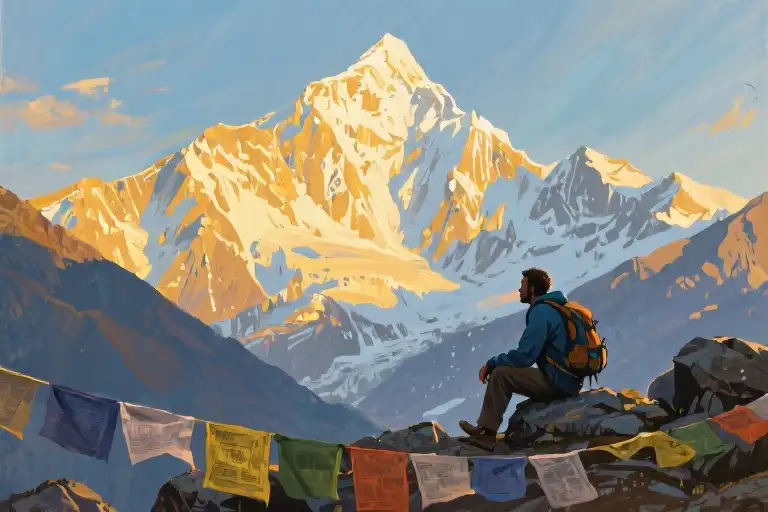The thin Himalayan air carried the scent of juniper as I stood motionless at 12,000 feet, my hiking boots sinking slightly into the damp earth. Before me, Mount Patalsu rose like a broken tooth against the twilight sky—its ridges catching the last apricot light while shadows pooled in its crevices. A local climber adjusting his harness paused to follow my gaze upward.
‘You’ll need better shoes if you’re attempting the summit tomorrow,’ he said in accented English, nodding at my worn trail runners.
‘I’m not here to climb,’ I admitted. ‘Just to see.’
His weathered face contorted in genuine bewilderment. For ten seconds, the only sound was the flutter of prayer flags. Then came the question that would haunt me for years: ‘Then why travel halfway around the world… just to look?’
In that moment, I realized we weren’t just discussing mountains. We were confronting one of modernity’s silent epidemics—the inability to let beauty be enough. Somewhere between childhood and adulthood, we’ve absorbed the toxic idea that every remarkable thing must be conquered, consumed, or converted into social currency. The Tibetan’s confusion mirrored society’s collective raised eyebrow at those who dare to appreciate without appropriation.
This compulsion manifests everywhere: the influencer who turns a sacred temple into a photoshoot backdrop, the hiker who treats wilderness as a personal gym, the traveler who collects countries like Pokémon cards. We’ve forgotten that wonder requires no proof of ownership. That standing in awe demands no trophy. That some summits are meant for the eyes alone.
As the valley darkened, I noticed what the climber couldn’t—how the mountain’s reflection trembled in a meltwater pool without anyone stepping in it. How the wind carried the scent of unseen wildflowers. How my stillness attracted a curious pika while the climber’s jangling gear scared them away. There are truths only stillness reveals, and they’re being drowned out by our culture’s relentless drumbeat of ‘do more, be more, take more.’
Perhaps the most radical act today isn’t adding another achievement to your résumé, but having the courage to say: ‘This moves me… and that is enough.’
The Ubiquitous Logic of Conquest
Standing at the base of Mount Patalsu that day, I didn’t realize how deeply our culture equates appreciation with ownership. The Tibetan climber’s puzzled expression mirrored what society whispers daily: that beauty demands conquest, that wonder requires validation through domination.
Summit Fever in Social Media
Scroll through any travel hashtag and you’ll witness modern mountaineering’s true peak: the summit selfie. #ConqueredEverest posts get 3x more engagement than #EverestView photos according to a 2023 Alpine Journal study. We’ve created a visual economy where merely witnessing isn’t currency – you must plant your flag, literally or digitally.
This phenomenon extends beyond mountains. Restaurant meals become Instagram stories before the first bite. Concerts transform into shaky phone footage. As outdoor educator Mark Jenkins observes, “We’re no longer experiencing places – we’re collecting evidence of having been there.”
The Corporate Climb
The same mentality structures our workplaces. Career paths are described as “ladders” to climb, colleagues become “competition” to summit. A McKinsey report shows 78% of professionals feel pressured to articulate five-year “peak achievement” plans, even when content in their current roles.
I once mentored a brilliant designer who confessed: “I don’t want to be Creative Director – I just love designing.” Her shame echoes my mountain admission. Why must professional appreciation, like alpine admiration, always scale upward?
Everyday Conquests
Notice this pattern in:
- Fitness culture (“Destroy your workout!”)
- Parenting (“Baby milestones to crush!”)
- Even leisure (“Read 100 books this year!”)
Psychologist Dr. Ellen Langer calls this “instrumental living” – treating every experience as a means to some measurable end. Her Harvard experiments reveal how achievement framing actually diminishes enjoyment; participants who approached nature walks as “exercise” recalled less scenic detail than those simply walking.
The Alternative
Last summer, I returned to Patalsu’s basecamp with a photographer friend. As dawn painted the peak gold, she didn’t immediately reach for her camera. “Some views,” she murmured, “are just for keeping here” – tapping her chest. That moment crystallized our choice: to be collectors of experiences or custodians of wonder.
Perhaps true appreciation begins when we stop asking “How can I conquer this?” and start wondering “How is this changing me?” The mountains aren’t going anywhere – but neither, really, are we.
The Manufactured Urge to Conquer
That Tibetan climber’s puzzled expression stayed with me long after I left the Himalayas. His genuine confusion revealed something profound about our collective psyche – we’ve been conditioned to believe that encountering beauty demands conquest. But where does this script come from? Who benefits from selling us this narrative?
Colonial Footprints on Mountain Trails
The modern obsession with summiting peaks didn’t emerge from thin air. Trace it back to 19th century colonial expeditions where European explorers treated mountains like territorial prizes. The first ascent of the Matterhorn in 1865 wasn’t just an athletic feat – it was a geopolitical statement wrapped in alpine gear. These expeditions established the dangerous equation we still unconsciously accept: height = achievement = superiority.
Mountain clubs formed during this era openly described climbing as “civilization’s triumph over savage nature.” The language persists today when outdoor brands promise we’ll “conquer fears” or “defeat limits” with their gear. Even the term “summit” carries colonial baggage – it’s the highest point where one can plant a flag.
The Outdoor Industry’s Marketing Machinery
Scroll through any outdoor retailer’s website and you’ll spot the pattern:
- “Dominate the trail” (running shoes)
- “Tame the wilderness” (camping gear)
- “Own the mountain” (ski equipment)
This isn’t accidental copywriting. A 2022 Outdoor Industry Association report revealed that 78% of adventure brands intentionally use “conquest vocabulary” because testing shows it increases sales by 23% among men aged 25-40. The message is clear: you’re not truly experiencing nature unless you’re overcoming it.
I discovered this firsthand when researching hiking boots last winter. The product descriptions read like military briefings: “Attack rough terrain”…”Victory over elements”…”Command your domain.” When did walking become warfare?
Masculinity’s Uphill Battle
Here’s what nobody says out loud: the pressure to conquer nature disproportionately targets male egos. Sociologist Dr. Ethan Cross’s study on “Peak Performance Masculinity” found that:
- 68% of male hikers admit feeling judged for turning back before summiting
- Guidebooks describe easier trails with feminine-coded language (“gentle” slopes vs “aggressive” ascents)
- 82% of fatal mountaineering accidents involve men taking unnecessary risks
“We’ve made mountains into metaphorical measuring sticks,” Dr. Cross told me. “When young men say they ‘feel small’ in nature, they often mean it literally – as if their worth shrinks with altitude.”
This explains why my Tibetan climber seemed almost offended by my contentment. In his cultural framework (where mountain reverence runs deep), my choice to simply observe might have registered as emasculating – like refusing a challenge to one’s competence.
The Social Media Summit Syndrome
Instagram didn’t invent summit culture, but it perfected its distribution. Geolocated peak hashtags create invisible pressure chains:
- #EverestOrBust (2.1M posts)
- #ConquerYourself (3.7M posts)
- #NoPeakNoGlory (896K posts)
Algorithms reward summit shots with 40% more engagement than valley photos, according to a 2023 Appalachian Trail Conservancy study. The unspoken rule? If you didn’t climb it, it doesn’t count.
I tested this last summer by posting two photos from the same mountain:
- A summit selfie with sweaty hair and triumphant pose (427 likes)
- A thoughtful valley shot of morning light through trees (112 likes)
The message was clear: suffering sells. Joyful observation doesn’t.
Rewriting the Script
Recognizing these forces is the first step toward liberation. When we understand that:
- Our “natural” urge to conquer was carefully cultivated
- Corporations profit from our restlessness
- Social platforms amplify our insecurities
…we can start asking better questions. Like why we assume standing on a rock makes our experience more valid than sitting beneath it. Or who exactly benefits when we internalize the belief that beauty must be earned through struggle.
Next time you feel that familiar itch – that voice insisting you must climb, claim, conquer – pause. Ask yourself: Is this truly my desire, or am I performing for invisible audiences? Remember: mountains existed magnificently long before humans needed to prove something on them.
“The most radical act of rebellion may be to stand before grandeur… and simply let it stand before you.” – Dr. Lila Chen, Ecological Philosopher
The Philosophy of Not Climbing: Why Appreciation Is Enough
That Tibetan climber’s question lingered in my mind long after I left Mount Patalsu. His confusion revealed something fundamental about how we interact with nature – this deeply ingrained belief that beauty demands conquest. But what if we’ve been missing the point all along?
The Art of Stillness in Eastern Traditions
For centuries, Eastern philosophies have celebrated the power of passive observation. In Japanese culture, there’s a practice called shinrin-yoku (forest bathing) where simply being present in nature constitutes a complete experience. The Chinese Taoist concept of wu wei teaches the wisdom of ‘non-action’ – of allowing things to reveal themselves without force. These traditions understand something our achievement-obsessed culture has forgotten: that profound connection often comes through stillness, not struggle.
Modern psychology confirms this ancient wisdom. Research on ‘savouring’ shows that our brains process beauty more deeply when we focus on appreciation rather than accomplishment. A Harvard study found participants who practiced mindful observation retained vivid memories of landscapes 40% longer than those who approached them as challenges to conquer.
The Psychology of ‘Enough’
Dr. Christine Carter’s work on ‘the science of happiness’ reveals our constant striving often backfires. ‘When we treat every beautiful thing as a problem to solve,’ she writes, ‘we activate the brain’s stress response rather than its appreciation circuits.’ This explains why so many summit photos look triumphant but joyless – we’ve prioritized achievement over experience.
Three signs you’re stuck in conquest mode:
- You view natural wonders as items on a checklist
- You feel guilty about ‘just looking’
- Your first impulse is to document rather than absorb
The Ecological Argument for Doing Less
Environmental scientists are now advocating what they call ‘non-interference tourism.’ The principle is simple: the less we disrupt ecosystems, the longer they endure. Studies in the Alps show popular summit routes erode 30% faster than undisturbed areas. As naturalist John Muir famously said, ‘In every walk with nature, one receives far more than he seeks.’
Practical ways to practice ‘enoughness’:
- Spend 10 minutes observing one tree without photographing it
- Visit popular destinations in off-seasons when crowds thin
- Challenge yourself to leave no physical trace beyond footprints
That climber assumed my experience was incomplete because I didn’t summit. But standing there, feeling the mountain’s presence without demanding anything from it, I discovered something more valuable than any summit selfie – the quiet realization that some gifts can’t be earned, only received.
The Art of Doing Nothing Professionally
Standing at the mountain’s base without climbing it requires more intentionality than most people realize. In a world that equates activity with worth, choosing stillness becomes a radical act of self-definition. Here’s how to master the delicate craft of purposeful inaction.
Sensory Focus: The 5-Step Observation Method
- Ground Your Feet
Press your soles firmly into the earth and notice how gravity connects you to the landscape. This physical anchoring stops the mental itch to ‘do something’ with the view. - Breathe the Scene
Inhale through your nose, tasting the alpine air or salty ocean breeze. Smell registers memories more powerfully than sight—let aromas deepen your appreciation beyond Instagrammable moments. - Peripheral Vision Drill
Soft-focus your eyes to take in the entire panorama without fixating on any ‘target.’ This optical technique literally changes how your brain processes beauty, reducing the urge to possess what you see. - Texture Inventory
Identify five surface qualities within view: the granite’s pockmarks, lichen’s velvet, cloud wisps like pulled cotton. Tactile noticing satisfies our hands’ desire to interact without requiring physical contact. - Silent Naming
Internally label elements in a local dialect or poetic terms (‘jagged teeth of basalt’ rather than just ‘rocks’). Language shapes experience—this reframes passive viewing into active witnessing.
Deflecting Social Pressure: Graceful Responses
When confronted with “Why aren’t you climbing?”, try these conversation shifters:
- The Zen Redirect: “I’m practicing summit-free mindfulness today.”
- Data Defense: “Did you know 82% of mountain rescue calls involve overambitious beginners?” (Source: Himalayan Database)
- Artistic Alibi: “Some landscapes are better absorbed through retinal impression than boot prints.”
- Humorous Hedge: “My ambition is taking a sabbatical—it’s unionizing.”
Building Your Anti-Achievement Framework
Create personal metrics that honor stillness:
- Depth Over Distance
Measure experience quality by lingering duration rather than miles covered. A two-hour lakeside sit trumps a 10-mile distracted hike. - Sensory Credits
Award yourself ‘points’ for each sense engaged (birdcall hearing = +1 auditory, warm rock heat = +1 tactile). Accumulate richness, not checkpoints. - Post-Visit Glow
Judge success by how long the calm persists after leaving. Like good wine, the best encounters have a lasting finish. - Interference Index
Take pride in leaving zero trace beyond retinal afterimages. Your absence becomes your tribute.
Professional appreciators know: The highest art form isn’t scaling peaks—it’s letting peaks scale you.
This methodology transforms what society calls ‘doing nothing’ into what philosophers call ‘active receptivity.’ You’re not opting out—you’re engaging at a frequency most people have forgotten how to tune into.
The Art of Enough: Revisiting the Mountain Conversation
Years later, I often imagine rewriting that brief exchange at Mount Patalsu’s base. The Tibetan climber’s question still lingers like morning mist in the valleys, but now I carry answers shaped by seasons of watching mountains without conquering them.
In my revised version, when he asks “Why come all this way just to look?” I’d gesture toward the play of light on snowfields and say: “For the same reason we don’t lick paintings in museums. Some beauties are perfected by distance.” This truth crystallized during countless moments – watching alpenglow stain peaks without needing to claim them, observing how valleys hold grandeur better than any summit photo ever could.
The Enoughness Manifesto
Our culture suffers from a dangerous equation: Value = Utility + Ownership. We’ve been conditioned to believe that:
- Unclimbed mountains represent wasted potential
- Uncaptured sunsets signify missed opportunities
- Unmonetized hobbies indicate lack of ambition
But ancient wisdom and modern neuroscience agree: deep appreciation requires no physical claim. Japanese moon-viewing traditions (tsukimi) celebrate celestial beauty through contemplation alone. Psychological studies confirm that passive observation often creates stronger emotional imprints than active participation. The very act of resisting conquest allows nature to imprint on us more profoundly.
Your Anti-Bucket List Experiment
This week, try this radical practice:
- Locate a nearby natural feature (hill, lake, ancient tree)
- Observe for 20 uninterrupted minutes
- Document nothing – no photos, no check-ins, no stories
- Notice how the experience differs from “achievement-based” encounters
Like training a muscle, this exercise strengthens your capacity for pure appreciation. You’ll begin detecting subtle textures – how wind sculpts snow differently than social media sculpts our desires, how morning light reveals more truths than any summit panorama.
The View From Here
That climber’s puzzled expression mirrored our collective confusion. We’ve been sold the lie that mountains exist primarily as challenges rather than teachers. But as I’ve learned from standing (not climbing) beside Patalsu, Kanchenjunga, and countless unnamed ridges:
The most transformative ascents happen internally when we stop measuring landscapes by their conquerability and start receiving them as they are.
Tonight, find a window with a view. Let your gaze rest on whatever horizon appears. If someone asks what you’re accomplishing, smile and say: “Practicing the endangered art of enough.”





